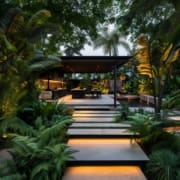Incorporating Water Features into Your Brisbane Landscape Design
Water features can transform a landscape, adding both aesthetic appeal and a soothing ambiance. In Brisbane’s subtropical climate, incorporating water elements into your garden design can create a serene retreat and enhance your outdoor living space. Here’s a guide to integrating water features into your Brisbane landscape design, ensuring a beautiful and functional result.
The Benefits of Water Features
Water features offer numerous benefits beyond their visual appeal. They can:
- Enhance Relaxation: The sound of flowing water promotes relaxation and can mask unwanted noise, creating a tranquil environment.
- Attract Wildlife: Bird baths, ponds, and waterfalls can attract local wildlife, adding life and movement to your garden.
- Improve Aesthetics: Water features serve as focal points in your landscape, adding interest and elegance.
Types of Water Features
There are various water features to consider, each offering unique characteristics and advantages. Some popular options include:
- Ponds: Ideal for larger spaces, ponds can be designed to accommodate fish, aquatic plants, and even small fountains. They provide a natural look and can be customised with various shapes and sizes.
- Waterfalls: Waterfalls can be integrated into rock formations or as standalone features. They create a dramatic effect and add the soothing sound of cascading water.
- Fountains: Suitable for both small and large gardens, fountains come in a variety of styles, from classical tiered designs to modern, minimalist looks.
- Streams: A stream can meander through your garden, connecting different water features and adding a naturalistic touch.
- Bird Baths: Simple yet effective, bird baths attract birds and add a charming element to your garden.
Planning Your Water Feature
Successful integration of a water feature requires careful planning. Consider the following factors:
- Location: Choose a location that complements your garden’s layout and is visible from key areas such as patios or living rooms. Ensure the site is accessible for maintenance and has a suitable water source.
- Size and Scale: Select a water feature that matches the scale of your garden. A large pond or waterfall may overwhelm a small space, while a small fountain might get lost in a large garden.
- Style and Design: Ensure the design of the water feature aligns with your overall garden style. Whether traditional, contemporary, or naturalistic, the feature should enhance the existing design elements.
Installation and Construction
Proper installation is crucial for the functionality and longevity of your water feature. Here are key steps in the process:
- Site Preparation: Prepare the site by clearing the area and ensuring proper drainage. For ponds and streams, excavation may be required.
- Choosing Materials: Select high-quality materials that suit your water feature type. For example, use waterproof liners for ponds and durable pumps for fountains.
- Professional Help: While some DIY enthusiasts may tackle smaller projects, complex water features often require professional installation to ensure proper setup and functionality.
Maintenance and Care
Regular maintenance is essential to keep your water feature in optimal condition. Key maintenance tasks include:
- Cleaning: Remove debris, leaves, and algae regularly to prevent clogs and maintain water clarity.
- Water Quality: Monitor and maintain water quality, especially in ponds with fish. Use water treatments as needed and check pH levels.
- Pump and Filter Care: Clean and inspect pumps and filters to ensure they are functioning correctly. Replace parts as needed to avoid malfunctions.
Integrating Water Features with Landscaping
To achieve a harmonious design, integrate your water feature with other landscaping elements. Consider:
- Surrounding Plantings: Choose plants that complement your water feature and thrive in Brisbane’s climate. Surround the feature with plants that enhance its appearance and provide natural filtering.
- Lighting: Incorporate lighting to highlight your water feature during the evening. Use underwater lights or spotlights to create a magical effect.
- Hardscaping: Use complementary hardscaping materials, such as stone or decking, to create a cohesive look around the water feature.
Enhancing Your Outdoor Experience
A well-designed water feature can significantly enhance your outdoor living experience. Whether you’re enjoying a quiet moment by a pond, listening to the gentle splash of a fountain, or observing wildlife around a bird bath, water features add a unique dimension to your garden.
Incorporating a water feature into your Brisbane landscape design offers both beauty and functionality. By carefully selecting and installing the right feature, and maintaining it properly, you can create a stunning outdoor space that enhances your home and provides a relaxing retreat.
For expert advice and professional installation, contact Live Outdoors to bring your vision of a perfect water feature to life.

